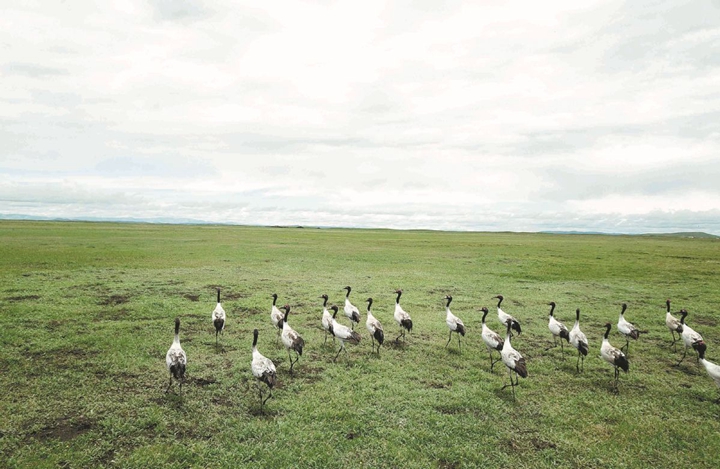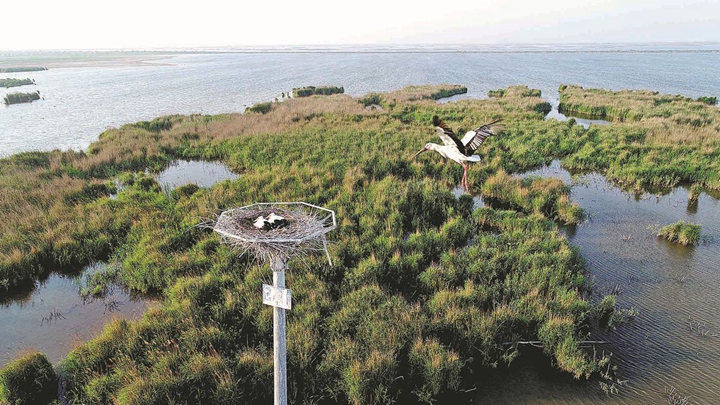Wetlands protection reaps rich rewards
China Daily2021-12-12 18:46
By ZHAO RUIXUE in Dongying, Shandong and MA JINGNA in Lanzhou

Black-necked cranes gather at Yellow River First Curve National Nature Reserve in Maqu county, Gannan Tibetan autonomous prefecture, Gansu province. CHINA DAILY
Birds benefit from vastly improved environment in Yellow River Delta
Deep into autumn, flocks of migratory birds arrive in quick succession in the Yellow River Delta in Dongying, Shandong province.
Late last month, large numbers of birds were seen resting on ponds beside a road more than 10 kilometers from the Yellow River Delta National Nature Reserve, which has been dubbed an "international airport for avian species".
At the reserve, flocks of birds flew across the sky and whooper swans glided slowly over the surface of lakes, while other birds chirped in the woods.
Zhao Yajie, who has monitored the condition of the birds for the reserve's management committee for seven years, said the Yellow River Delta, one of the largest in China, has a temperate, semi-humid continental monsoon climate. It is a place for millions of birds to breed and is also a winter stopover for them.
"Last year, about 6 million birds stopped over at the reserve, including rare species such as the red-crowned crane and the Saunders's Gull," Zhao said, adding that flamingos and white pelicans were observed there for the first time last year.
Meanwhile, in Gansu province, Wang Jiayang, who works for a management and protection center station at Yellow River First Curve National Nature Reserve in Maqu county, Gannan Tibetan autonomous prefecture, said that in November last year some 30,000 birds stopped over at the reserve's wetlands. It was the first time that so many birds had been witnessed at the venue, which is located on the upper reaches of the waterway.
Gou Hongshui, director of the Yellow River Delta National Nature Reserve's management committee from 2019 to May this year, said: "Birds know whether an environment is good or not. Increasing numbers of migratory species are stopping over at the reserve. Some make it their home all year-good evidence that the delta's ecological system is constantly improving."
Rising in the Bayan Har Mountains in Qinghai province, the Yellow River, China's second-longest, flows through a plateau blanketed with fine, windblown soil. Millions of tons of soil are carried east by the river every year, with some of it reaching the estuary, where the waterway flows into the Bohai Bay in Dongying, forming a large expanse of wetlands.
In the 1980s and '90s, coastal erosion, seawater encroachment and droughts caused the wetlands to shrink.
The delta's rich wetland ecosystems are also seriously threatened by rapid urbanization, oil and industrial waste pollution, and unprecedented land reclamation, according to the reserve's management committee.
To protect the wetlands, the reserve was established in 1992. It covers about 153,000 hectares, with the wetlands comprising 70 percent of the total.
President Xi Jinping, who is also general secretary of the Communist Party of China Central Committee, inspected the Yellow River estuary, including the reserve, on Oct 20.
He checked the river's tributaries, the wetlands' environment and learned about ecological protection and high-quality development in the Yellow River Basin.

An Oriental stork flies to its nest on a pole at the Yellow River Delta National Nature Reserve. YANG BIN/FOR CHINA DAILY
An outline for the Basin's protection and development through 2030, released in early October by the central government, calls for the protection and restoration of wetlands on the lower reaches of the delta.
Local governments have prioritized protection of the reserve, with such efforts strengthened in the past three years. This work followed a symposium on ecological conservation and high-quality development in the Yellow River Basin chaired by Xi in Henan province in 2019.
Gou said, "As water is crucial to maintaining the healthy ecological system in the wetlands, we have been replenishing the water there."
Water projects have made replenishment possible. For example, local governments use the Xiaolangdi Hydroelectric Power Plant on the middle reaches of the river in Henan to regulate the waterway's flow by storing floodwater to be released when needed.
Dikes have been built at the wetlands to conserve water, helping restore surface runoff and supplement groundwater supplies.
To date, 160 million cubic meters of water has been replenished in the delta this year, according to the Department of Natural Resources in Shandong.
Gou said the abundance of water in the wetlands has significantly contained destruction of the ecosystem caused by seawater encroachment, and has also slowed soil salinization.
In 2006, the reserve teamed up with the Chinese Academy of Sciences to tackle Spartina alterniflora, a smooth type of marsh cordgrass spreading widely on the estuary coastline and seriously threatening species' habitats.
This cordgrass can have serious ecological consequences by changing the terrain of the intertidal area, hindering the flow of tidal ditches and water channels, replacing indigenous plants, and reducing key habitats for water birds wintering and breeding.
Liu Jing, director of the environmental monitoring center at the nature reserve, said: "The soil where this cordgrass grows was turning black. It not only causes biodiversity changes and ecosystem imbalances, but also has an important impact on the natural wetland landscape."

Zhao Yajie (right) and her teammates conduct research on vegetation at the reserve. WANG LIDONG/FOR CHINA DAILY
A large expanse of Spartina alterniflora was eliminated last year, she added.
Such efforts have resulted in more than 18,800 hectares of the wetlands being restored since 2017, according to the nature reserve.
To advance ecological conservation and high-quality development at the mouth of the river, local governments are working on building a Yellow River estuary national park, which will cover 2,152 square kilometers of marine area and 1,371 sq km of land, according to the reserve.
The national park will be the first in the country to boast land and marine areas.
The outline for the Yellow River Basin's protection and development through 2030 calls for further efforts to be made to restore key wetlands on the upper reaches of the Basin, such as those in Gannan.
Wang, from the management and protection center station, said authorities have also taken steps to better protect the wetlands in Maqu, which play a crucial role in conserving water for the Yellow River.
Maqu, located in the eastern part of the Qinghai-Tibet Plateau at an average altitude of 3,600 meters, is where the Yellow River makes its first curve. The wetlands are dubbed the river's "water pool".
For the past five years, the central government and the authorities in Gansu have launched 70 projects to restore the wetlands and monitor their environment.
Wang said the increasing number of birds breeding at the Maqu wetlands shows that the ecological systems there are improving.

The wetlands at the Yellow River Delta National Nature Reserve. HU YOUWEN/FOR CHINA DAILY
Biodiversity enriched
Liu, from the monitoring center, said this good environment has enriched biodiversity, and according to the delta nature reserve, the wetlands are now home to 1,630 wild animal species and 685 plant species.
A line on the big screen at the monitoring center indicates changes in the number of birds living or stopping over in the delta. It also shows that the number of avian species in the delta has risen from 187 in 1992 to 371.
Liu said: "We observed flamingos in March, white pelicans last December and spoon-billed sandpipers this year. More than 10,000 Saunders's Gulls bred at the reserve this year."
In addition, many Oriental storks live at the nature reserve throughout the year.
Zhao, the monitoring worker, said: "Oriental storks, an endangered species, gave birth at the nature reserve for the first time in 2005. Last year, they gave birth to 324 nestlings, and 2,278 of these storks have been born at the reserve."
The 34-year-old can identify more than 170 species of birds, and she has a wealth of experience in caring for her charges, such as building homes for the birds and creating a friendly and suitable environment on land and water for different species.
"Oriental storks like building nests in tall arbor trees, but because we have few of these trees, we have built nests for the birds on poles standing 15 meters to 17 meters high," Zhao said.
To date, 115 nests have been built for Oriental storks, she added.
"The nests, which are shaped like bowls, are 1.2 meters in diameter at the base, 2.2 meters in diameter at the top, and 35 centimeters deep. Birds place branches and leaves inside the nests, making warm homes for themselves in these artificially built structures," she said.
Zhao is among 20 people working at the reserve who monitor the birds' conditions every day.
Coastal waters near the Yellow River Delta are also important for marine life in the Yellow Sea and Bohai Bay to spawn, winter, feed and migrate, according to the nature reserve.
More than 2,000 swans, 40 red-crowned cranes and thousands of wild geese, gray cranes and wild ducks are now arriving daily in the delta, according to the nature reserve.
Zhao said: "When we walk around this vast reserve, we are not alone, as the birds are everywhere-on lakes, in woods and across the sky. It will be a beautiful winter."

A mallard leads her ducklings on a walk through seagrass at the reserve. LIU YUELIANG/FOR CHINA DAILY
